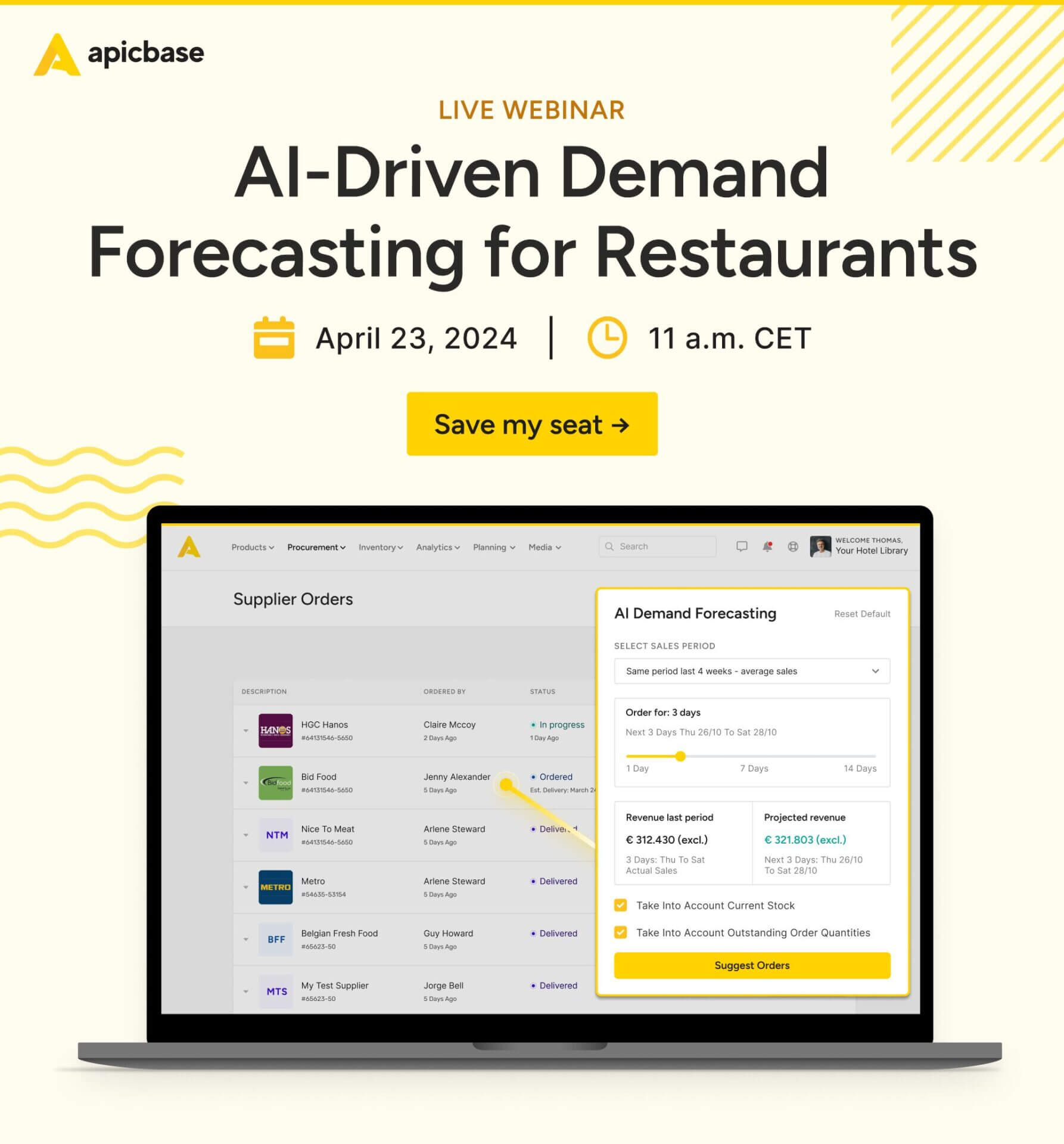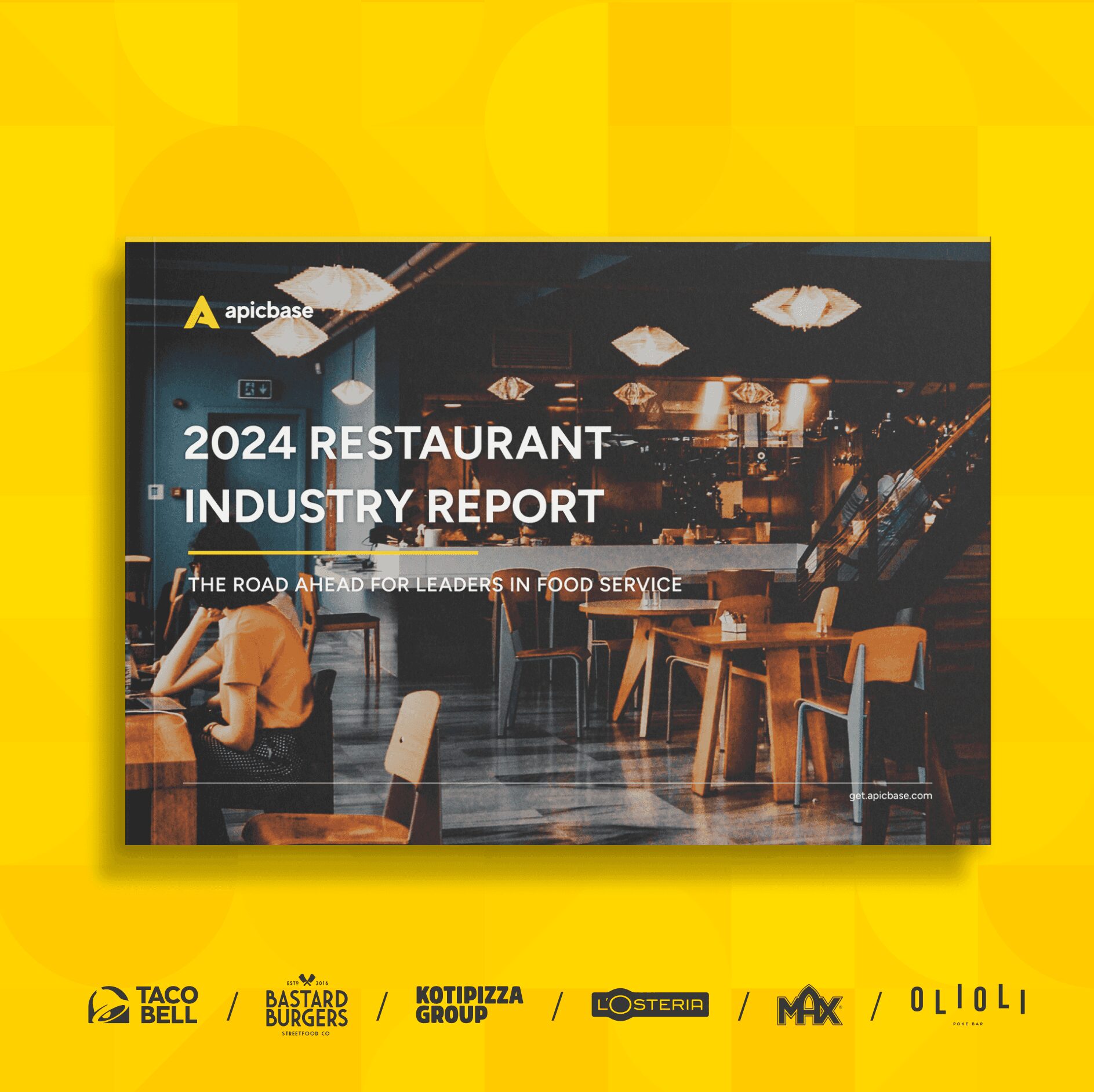The restaurant industry is transitioning from a static and predictable environment to a dynamic and innovative one. Let’s unravel the restaurant industry trends for 2024.
What is Going On?
For decades, customer expectations, business models, and business strategies in the restaurant industry haven’t changed much. Things were more or less predictable.
Today, the restaurant industry is in a state of flux. Inflation, labour shortages and changing consumer behaviour have intensified historical challenges such as tight profit margins and high staff turnover.
This new reality is pushing restaurant businesses to overhaul their operating models.
It’s exciting.
Putting the various trends side by side, an overarching trend emerges: the restaurant industry is moving from:
- rigid, traditional models to
- a dynamic, responsive and technologically integrated approach.
Innovation lies at the core of this trend, and the pace of change is accelerating.
Restaurant companies clinging to a wait-and-see strategy may soon find themselves needing to catch up in the face of the transitions in the food service market.
Join us as we dive into the restaurant industry trends for 2024.
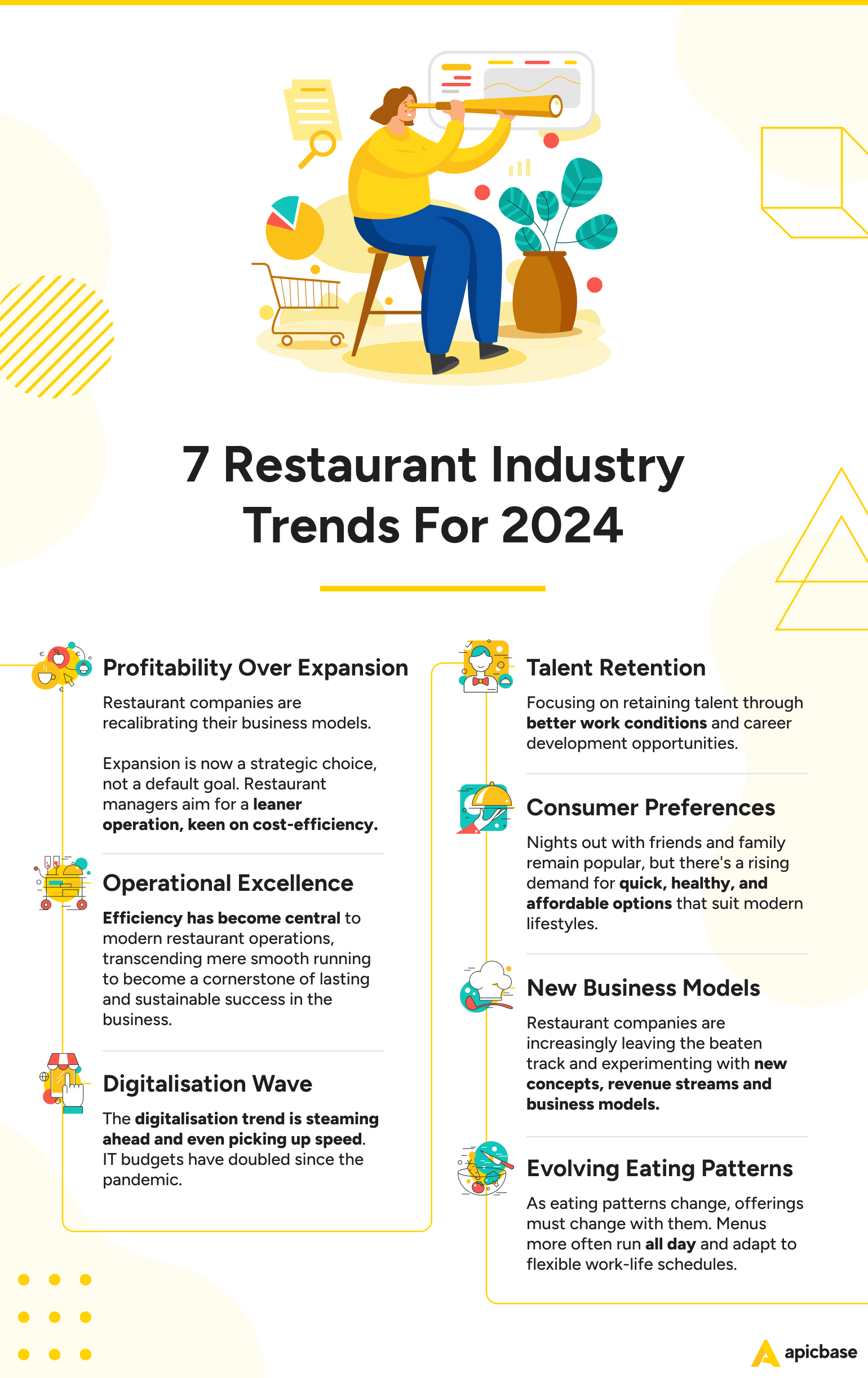
Restaurant Industry Trends: Index
From Opex strategies to new business models, let’s look at the most compelling trends shaping the European food and beverage industry in 2024.
- Profitability over expansion
- Operational excellence as a core strategy
- The digitalisation wave
- Addressing staff shortages with talent retention
- Catering to changing consumer behaviour
- Innovating in food and business models
- Adapting to evolving dining patterns
- Conclusion
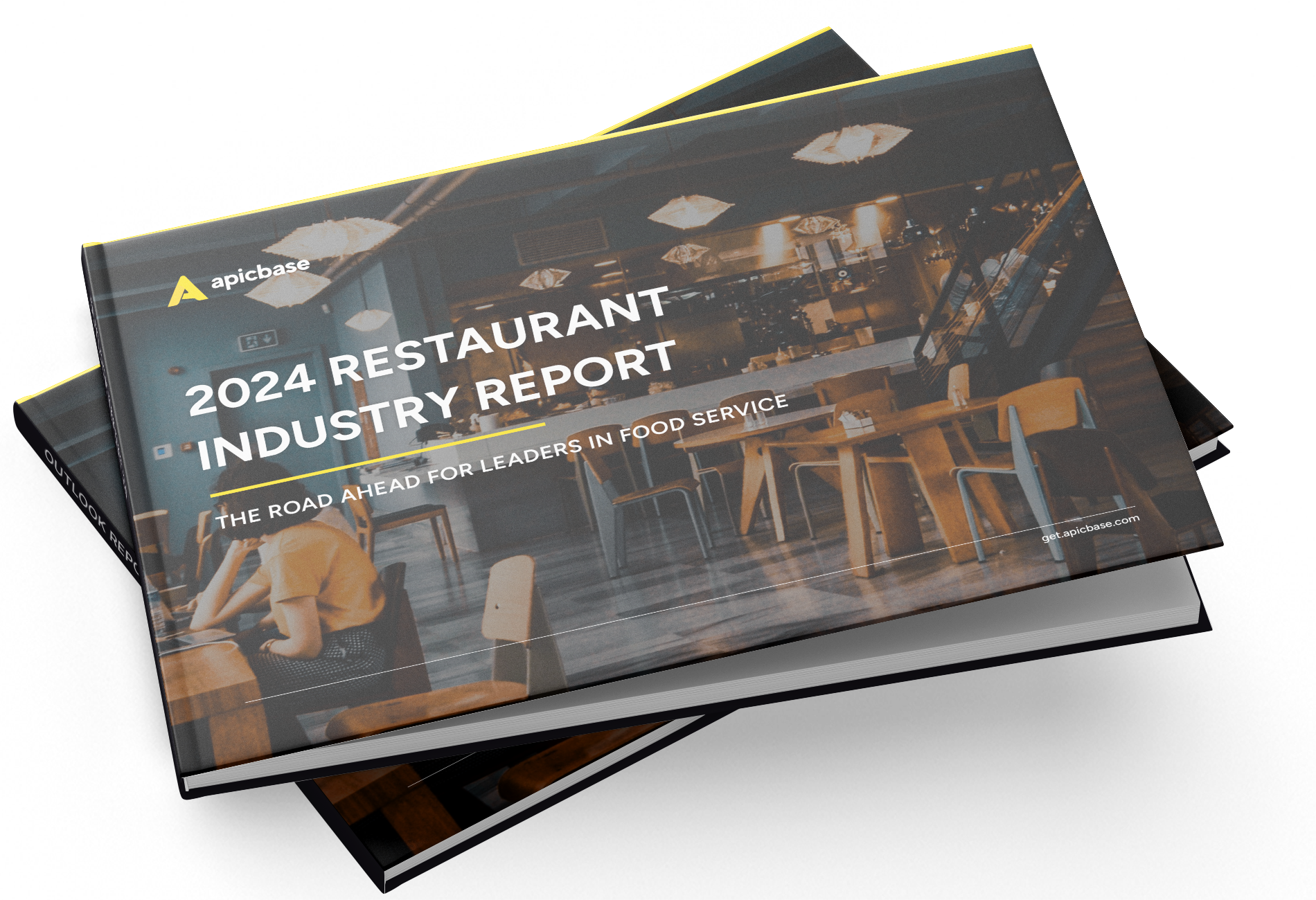



2024 Restaurant Industry Report
Read how successful restaurant leaders are tackling challenges in the foodservice industry.
👉 No form, no fuss. You get instant access.
1. Profitability Over Expansion
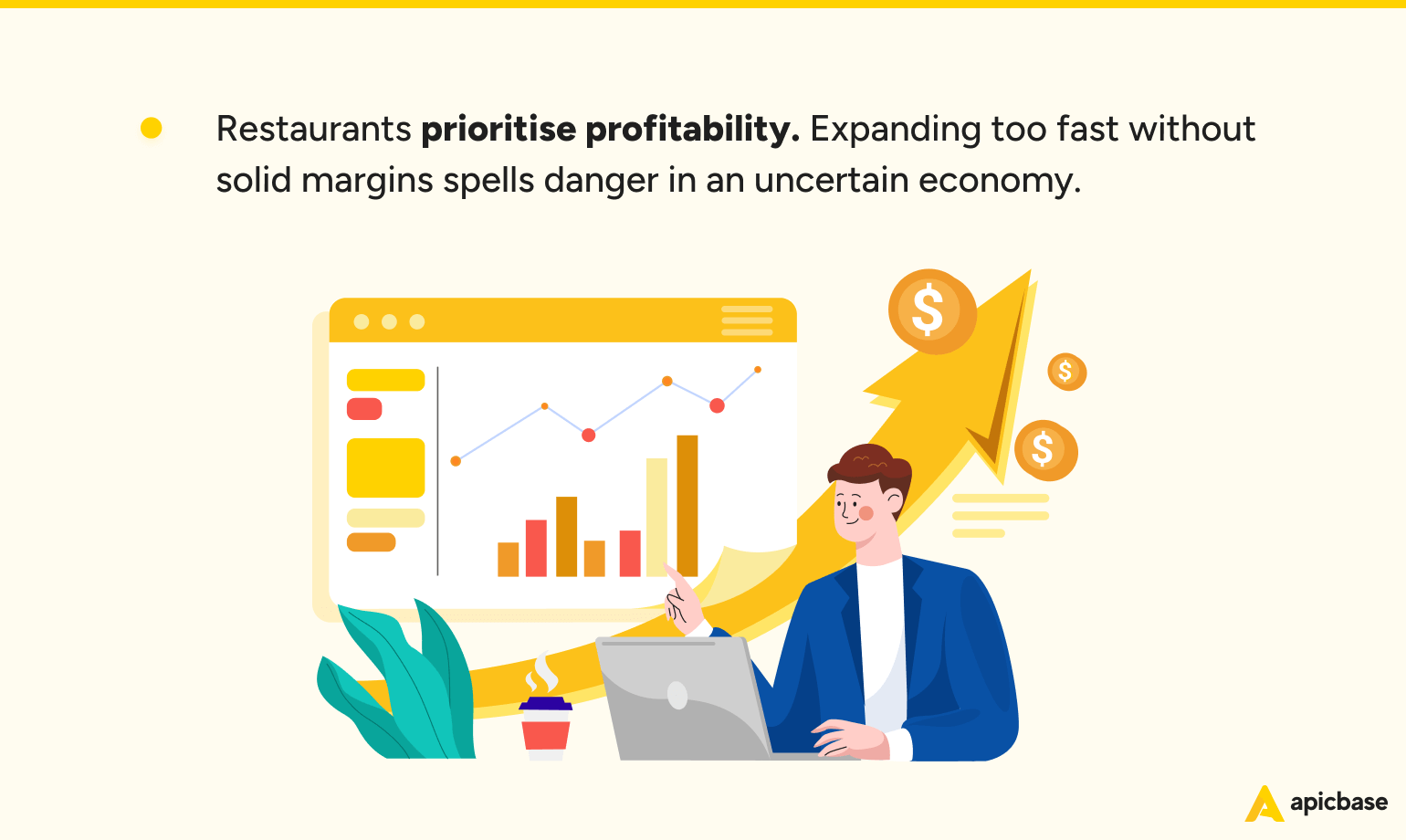
Operating on thin margins in a volatile economy spells danger.
That’s why, in 2024, restaurant companies are recalibrating their business models. Expansion is now a strategic choice, not a default goal. Restaurant managers aim for a leaner operation, keen on cost-efficiency.
Growth is still essential, but profitability is taking centre stage.
- Before: The model used to be expansion-driven, focusing on opening new locations and increasing market presence.
- Now: Emphasis on profitability and financial sustainability rather than just expansion.
Why the shift?
The combination of economic ups and downs and the understanding that fast growth might stretch resources too thin has sparked this shift in thinking.
In the past, food service companies often pursued growth, even at the cost of thinning margins, but the new economic landscape demands a more balanced approach. Food service businesses and their investors recognise that lasting success relies on robust financial health rather than having a wide presence.
Impact of the trend
- On business models. Restaurant companies are scaling up only when it’s financially viable, prioritising efficient operations.
- On operations. On the one hand, tighter cost control and strategic pricing lead to improved financial health. And, streamlining menus, optimising operations and reducing food waste enhances efficiency and customer experience.
On the other hand, innovation in menus and services also comes at a cost. Managing these costs is crucial. It ensures that the investments actually lead to higher profitability without compromising financial health.
2. Operational Excellence as a Core Strategy

The aim is to become more resilient and adaptable.
Efficiency has become central to modern restaurant operations, transcending mere smooth running to become a cornerstone of lasting and sustainable success in the business.
- Before, the focus was primarily on revenue growth and business expansion.
- Now, an emphasis on bottom-line control flanks the expansion targets. Profitable growth is the name of the game. Restaurant companies are tackling this by refining processes, improving efficiency and maximising resource utilisation.
Why the shift?
The increased food and labour costs and fierce competition have sparked the shift.
Previously overlooked inefficiencies, such as supplier consolidation, optimisation of ingredient usage, and food cost variance, are now identified as significant risks threatening a restaurant’s survival.
By focusing on operational excellence, restaurants ensure they get the most out of every resource, thereby maximising value.
Impact of the trend
- On business models. A business model centred around operational excellence typically results in higher profitability. This approach leads to a leaner, more agile way of working that can adapt to market changes. The end goal is to offer competitive pricing while maintaining quality. It makes attracting and retaining customers easier.
- On operations: Operational Excellence (OpEx) hinges on streamlining workflows and processes, investing in staff training to boost productivity, and embracing technology for better inventory management and scheduling.
However, this transition has its challenges. Introducing new processes and technologies can temporarily shake up the daily flow of operations.
Additionally, overcoming staff resistance is challenging, as employees may need to acquire new skills or adjust to different working methods.
3. Surfing The Digitalisation Wave
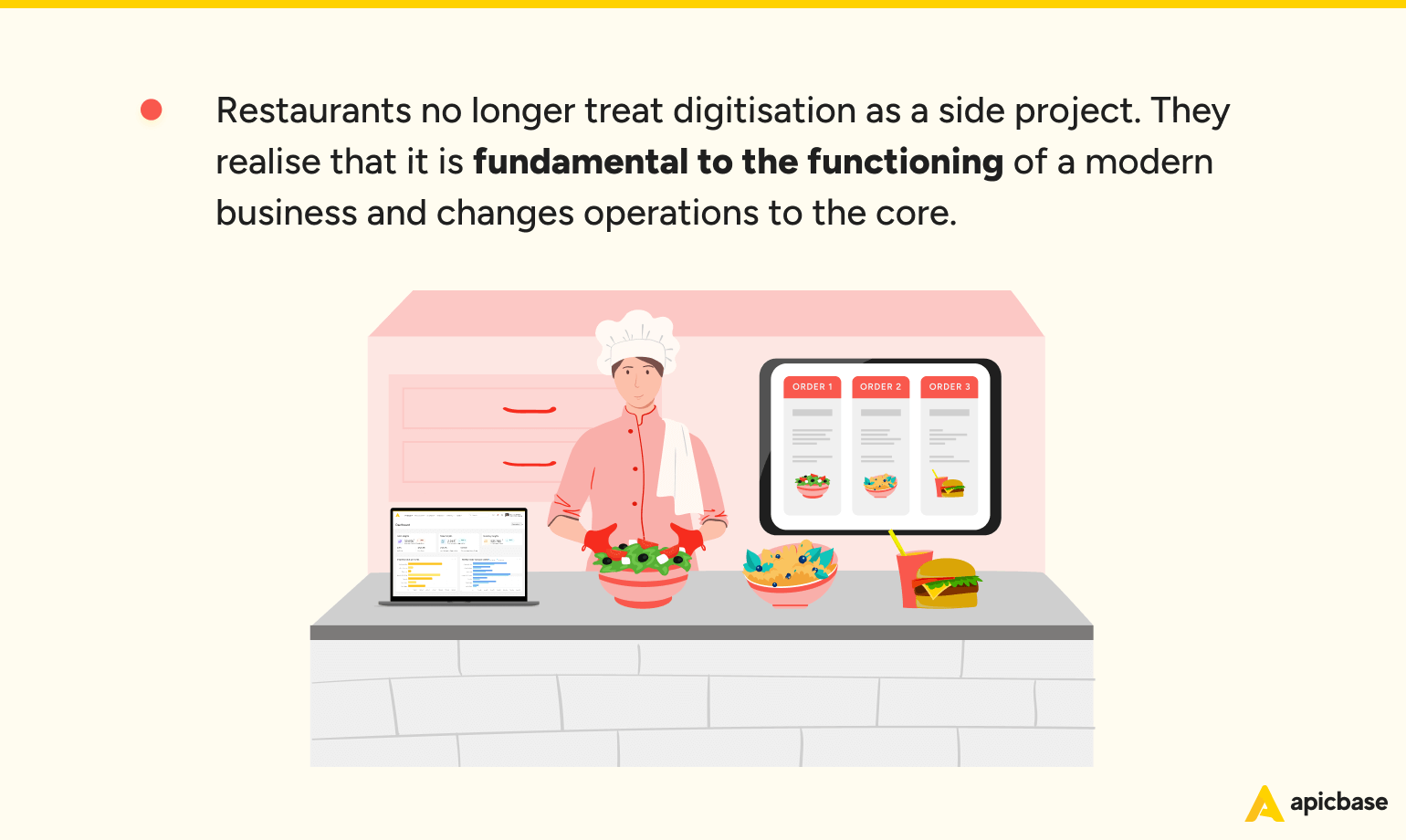
The digitalisation trend is steaming ahead and even picking up speed. IT budgets have doubled since the pandemic.
The reasons are plenty. Digital tech opens up opportunities for customer engagement and new service delivery channels, such as online ordering and delivery apps, social media marketing, and loyalty programs.
In short, digitalisation is diversifying the traditional restaurant business model.
Additionally, it enables efficiencies in menu engineering, inventory, and supplier management. Given the high operating costs and increased need for flexibility in the food service industry, these are crucial gains.
Digitalisation, of course, isn’t a new trend. However, what is new is that it isn’t a side project any more. A robust digital infrastructure is now fundamental to the functioning of modern restaurants. It affects everything from customer interactions to kitchen operations.
- Before: Manual processes with limited use of technology in operations and customer interactions.
- Now: Comprehensive integration of digital tools in all aspects of business, from generating purchase orders to customer relationship management.
Why this change?
The push for more tech in restaurants comes from two significant needs: keeping up with tech-loving customers and streamlining cumbersome and manual processes in the kitchens and the service areas. Digital tools do both, enabling more efficient use of restaurant resources.
What’s more, restaurant analytics software collects all the data in clear dashboards, giving restaurant teams the insights they need to align customer demands with the supply chain.
Impact of the trend
- On business models: digitalisation opens up new revenue streams, enhances customer engagement and offers new capabilities for data analysis.
- On Operations: Adopting dedicated technology leads to more efficient, data-driven operations. It improves customer service and smoothens backend processes, ensuring a seamless flow from kitchen to table.
However, embracing digitalisation has its challenges.
Staff accustomed to traditional methods may initially resist adopting new digital tools and processes. This resistance underscores the importance of careful change management and training.
The success of the transition to the digital age will depend on how well restaurant leadership manages the change.
Recommended read: Apicbase’s Onboarding Process: How Our Customer Success Team Ensures Rapid Adoption and Maximum ROI at Multi-site Restaurants.
4. Addressing Staff Shortages = Talent Retention

High turnover rates were considered a given in the restaurant industry for a long time.
That attitude was justified because most jobs required little experience, and plenty of labour was available. That situation is completely reversed. Working in food service requires much more specialised knowledge, and workers have job options outside the restaurant sector.
As a result, finding and keeping talented employees became much more complicated.
- Before, high turnover rates were the norm in the industry.
- Now: Focusing on retaining talent through better work conditions and career development opportunities.
Why It’s Changing
Staff shortages are driving the shift from primarily hiring to focusing on retention. But there is more.
The food market is highly competitive. New players with deep pockets, i.e. retail brands, have entered the pitch. Restaurant leadership teams understand that a stable and well-trained staff is a powerful weapon to capture and retain a corner of the market. It creates an extra incentive for restaurant management to do whatever they can to keep talented employees on board.
Impact of the trend
- On business models: A model emphasising staff retention typically leads to a more stable and reliable brand image. It also helps build a loyal customer base, as consistently good service encourages repeat business.
- On operations: There are fewer hiring and training costs. Employee morale and productivity improve. Customer experience is more consistent.
The downside is that higher wages and better benefits will increase operational costs. Also, training programs require time and resources. Restaurants will have to prepare accordingly.
5. Catering to Changing Consumer Preferences

Nights out with friends and family remain popular, but there’s a rising demand for quick, healthy, and affordable options that suit modern lifestyles.
This trend in food service is narrowing the gap between restaurants and retail. Retail has traditionally been the king of convenience, while restaurants have reigned supreme in offering unique experiences.
As restaurants adapt to meet these demands, they move closer to the retail model (well-defined product range, price sensitivity, on-the-go). Conversely, retail is also vying for customers who seek quick, healthy, and affordable meals. For instance, the F&B offer of petrol stations has received a remarkable upgrade over the last few years.
This convergence intensifies competition between the two sectors, as each strives to capture a share of the consumers’ spending on food.
- Before, static menu offerings and a one-size-fits-all service model.
- Now: Adapting to evolving consumer preferences with diverse, often personalised, menus and flexible service models.
This trend fundamentally reshapes the restaurant industry, putting established strategies and previously solid business models to the test.
Why It’s Changing
First, the trend towards convenience, quality, and affordability fits today’s lifestyle. We’re all running around, so grabbing a bite shouldn’t be another chore on the list—it has to be easy, tasty, and not break the bank.
Second, technology has changed the game, making it super easy to order food online or get it delivered. People increasingly expect the same convenience from all their food purchases. It should be hassle-free.
Third, with everyone trying to eat healthier, the demand for quality food is up. But, since many people are watching their spending, it’s also important that this food is affordable.
Impact of the trend
- On business models: The changing consumer preferences require businesses to be more versatile and responsive to market trends. It might lead to a more segmented approach, with different offerings catering to various consumer segments.
- On operations: Flexibility is paramount. Operations must be agile enough to tweak menus, cater to diverse dietary needs, adjust service models, and roll out marketing strategies that resonate with the shifting consumer landscape.
This flexibility will likely disrupt kitchen operations, which may create resistance among staff. Therefore, extra attention should go to inventory management and staff training.
6. Innovation in Product and Business Models
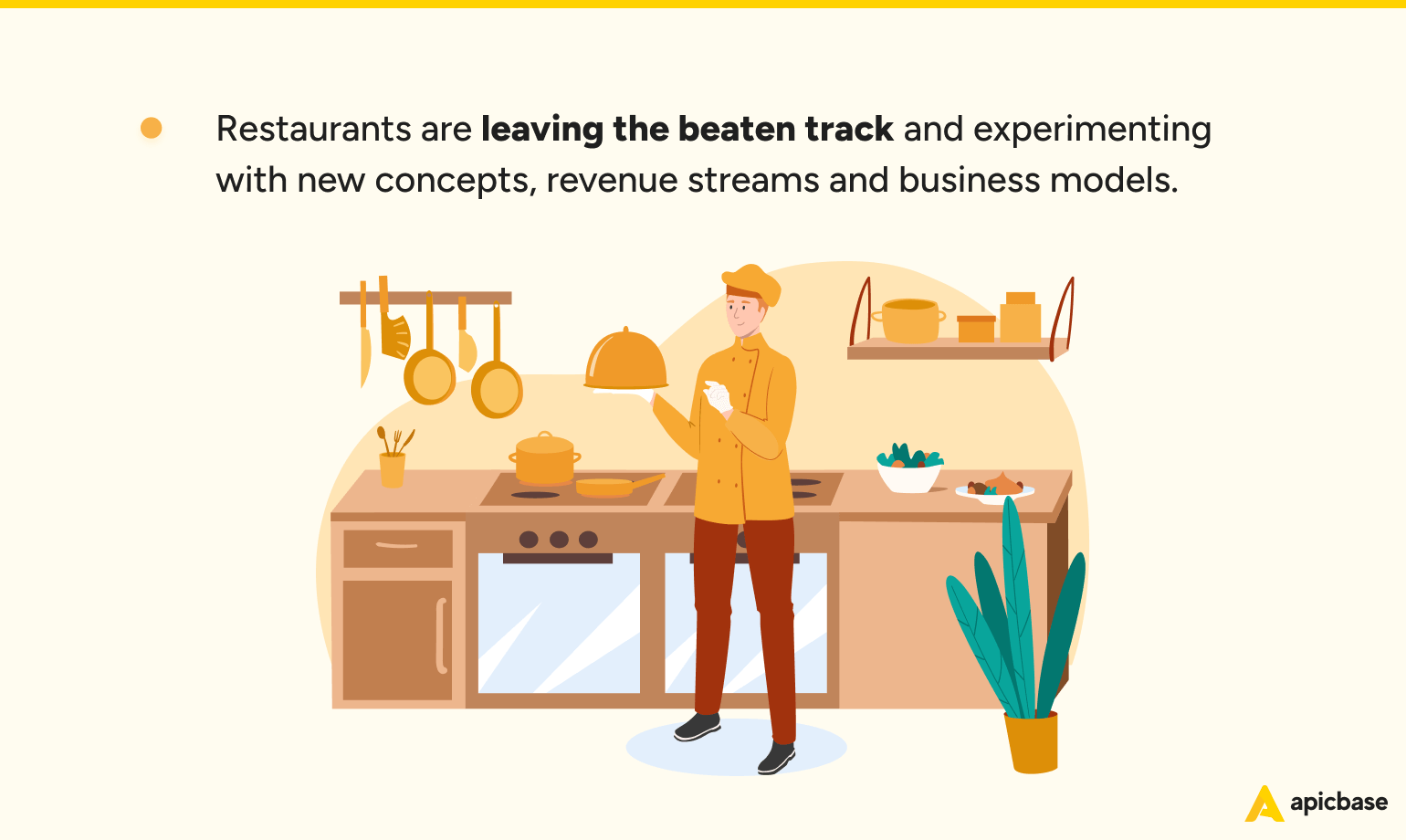
Restaurant companies are increasingly leaving the beaten track and experimenting with new concepts, revenue streams and business models.
They innovate because the old way of doing things doesn’t match customer demand and technological advancements, nor does it provide an appropriate response to the activities of their competitors.
- Before, restaurateurs relied on traditional menus and dining experiences.
- Now, they embrace menu design innovation and explore new business models like ghost kitchens and, increasingly, central production kitchens.
Why the shift
Driving the innovation trend is the need for differentiation. Restaurant brands must stand out in a crowded market. Additionally, changing consumer behaviour – quick, healthy and affordable – encourages restaurants to think beyond traditional working methods.
In short, food service operations need to stay competitive in a changing market.
Impact of the trend
- On business models: Restaurant companies are developing niche markets and unique dining concepts. It leads to diversification and creates new revenue streams. For instance, a traditional dine-in restaurant might also operate a ghost kitchen on top of its regular services, tapping into the delivery market.
- On operations: It’s about being nimble. Innovation requires agility in kitchen operations, the ability to adapt to new market trends quickly, and the readiness to experiment with new food concepts and service models. When restaurants don’t prepare, innovation can put a strain on resources. There is always a risk of (untested) concepts failing to resonate with customers.
7. Adapting to Evolving Eating Patterns
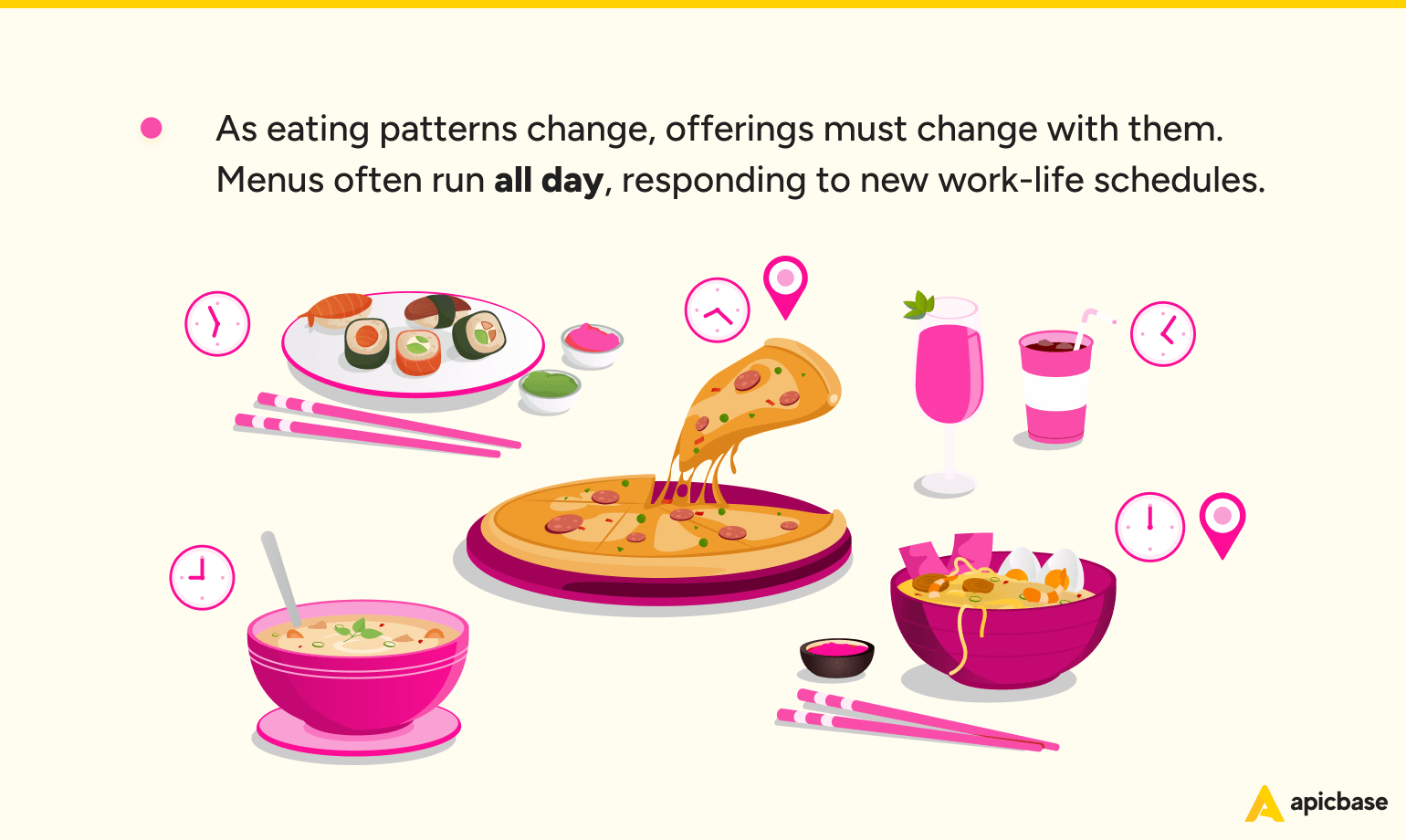
It used to be simple. Friday, Saturday and Sunday are great days for business. Mondays and Tuesdays are slow. From Wednesday on, things start to pick up. The same goes for peak times during the day: lunch and dinner were predictable. That’s over.
The evolving consumer lifestyles and preferences impact traditional dining patterns.
- Before, peak times were predictable.
- Now: All-day offer.
Why it’s changing
Work-life patterns are changing, with remote work and flexible schedules becoming more widespread. These changes influence not only when people purchase food but also their eating habits.
Impact of the trend
On business models: More dynamic service hours and offerings to cater to the new dining patterns. This might involve offering services that were previously not a focus, like:
- Expanded breakfast menus for early lunch;
- Improved takeaway options for dining at non-traditional hours,
- Smaller portions for a quick lunch or an affordable treat.
On operations: Evolving visitor patterns require flexible staffing and more intelligent inventory management. It’s about agility and having the ability to adapt to fluctuating demand.
This change can introduce complexity in kitchen operations and might also meet resistance from staff as they adapt to new methods that are different from their usual routines.
Restaurant Industry Trends 2024: Conclusion

The restaurant industry trends for 2024 show that the sector is undergoing a profound metamorphosis.
A closer look reveals that these changes are more than reactive measures. Restaurant leaders are proactively building a resilient future. They’re adopting innovative strategies and business models that depart from the beaten paths.
The trends highlight a critical insight: the future of the restaurant industry lies in agility, technological integration, and a deep understanding of the changing consumer landscape.
Restaurant leaders should focus on embracing change, driving innovation, and prioritising the well-being of both staff and customers. By aligning with these trends, businesses can remain competitive and sustainable.

Make Profits Predictable.
Apicbase is the control centre for every aspect of daily operations in large-scale foodservice companies.
It’s time to take charge of the change, not merely adapt.

